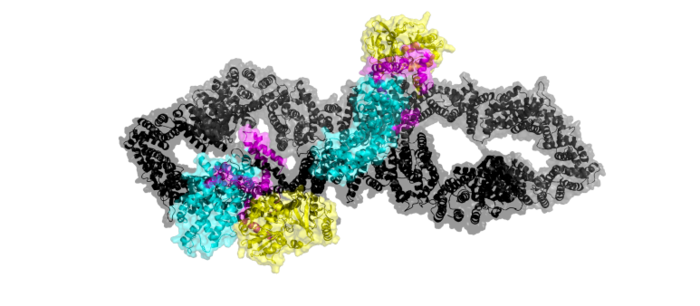Sandbox Reserved 1706
From Proteopedia
(Difference between revisions)
| Line 20: | Line 20: | ||
====N-C HEAT/ARM==== | ====N-C HEAT/ARM==== | ||
| - | The N-C HEAT/ARM are two separate but similar connected domains that make up the backbone of the protomer; <scene name='90/904311/N-heatarm_open/2'>N-HEAT/ARM</scene>(N-Terminal) and <scene name='90/904311/C-heatarm_open/2'>C-HEAT/ARM</scene>(C-Terminal). [https://en.wikipedia.org/wiki/HEAT_repeat HEAT] and [https://en.wikipedia.org/wiki/Armadillo_repeat ARM] are acronyms for a trope of repeating helical structures. Structurally, the N-HEAT/ARM consists of various helices and loops that interconnect on one of the existing protomers. The N-HEAT/ARM is critical in stabilization and linking the catalytic and core domains. The N-HEAT/ARM in its linkage with the GRD catalytic domain also has a direct impact on the relative conformational change from the active (Ras BOUND) to inactive (Ras unbound) states. The Zn2+ binding site also extends from the N-HEAT ARM just before the GRD and SEC14-PH domains. The C-HEAT/ARM plays similar roles to the N-HEAT/ARM by stabilizing and linking the GRD and SEC14-PH domain and contributing to the conformational changes from the closed to open state.<ref name="Lupton"> DOI:10.1038/s41594-021-00687-2 | + | The N-C HEAT/ARM are two separate but similar connected domains that make up the backbone of the protomer; <scene name='90/904311/N-heatarm_open/2'>N-HEAT/ARM</scene>(N-Terminal) and <scene name='90/904311/C-heatarm_open/2'>C-HEAT/ARM</scene>(C-Terminal). [https://en.wikipedia.org/wiki/HEAT_repeat HEAT] and [https://en.wikipedia.org/wiki/Armadillo_repeat ARM] are acronyms for a trope of repeating helical structures. Structurally, the N-HEAT/ARM consists of various helices and loops that interconnect on one of the existing protomers. The N-HEAT/ARM is critical in stabilization and linking the catalytic and core domains.<ref name="Bergoug"> DOI:10.3390/cells9112365</ref> The N-HEAT/ARM in its linkage with the GRD catalytic domain also has a direct impact on the relative conformational change from the active (Ras BOUND) to inactive (Ras unbound) states. The Zn2+ binding site also extends from the N-HEAT ARM just before the GRD and SEC14-PH domains.<ref name="Naschberger"> DOI:10.1038/s41586-021-04024-x</ref> The C-HEAT/ARM plays similar roles to the N-HEAT/ARM by stabilizing and linking the GRD and SEC14-PH domain and contributing to the conformational changes from the closed to open state.<ref name="Lupton"> DOI:10.1038/s41594-021-00687-2</ref> |
====GRD==== | ====GRD==== | ||
| - | Neurofibromin’s main catalytic domain is the <scene name='90/904311/Grd_open/2'>GRD</scene> binding site. Linked structurally to both HEAT/ARMs, it consists of mainly loops and helices. There is one single GRD binding site per protomer. In the closed state, Ras cannot bind the GRD site due to a steric hindrance in which Ras clashes with the N-HEAT/ARM. Within the GRD site, the critical binding site residue is Arg1276. GRD also can bind to SPRED-1 to be recruited from the cytosol to the plasma membrane. <ref name="Lupton"> DOI:10.1038/s41594-021-00687-2</ref> | + | Neurofibromin’s main catalytic domain is the <scene name='90/904311/Grd_open/2'>GRD</scene> binding site. Linked structurally to both HEAT/ARMs, it consists of mainly loops and helices. There is one single GRD binding site per protomer. In the closed state, Ras cannot bind the GRD site due to a steric hindrance in which Ras clashes with the N-HEAT/ARM.<ref name="Naschberger"> DOI:10.1038/s41586-021-04024-x</ref> |
| - | + | Within the GRD site, the critical binding site residue is Arg1276. GRD also can bind to SPRED-1 to be recruited from the cytosol to the plasma membrane. <ref name="Lupton"> DOI:10.1038/s41594-021-00687-2</ref> | |
====GAPex==== | ====GAPex==== | ||
The <scene name='90/904311/Gapex_open/2'>GAPex</scene> of the GRD site lies between the Sec14-PH and GRD catalytic sites. This domain is non-catalytic and structurally consists of various loops and helices. Its may contribute to the binding of SPRED-1 to the GRD site. <ref name="Lupton"> DOI:10.1038/s41594-021-00687-2</ref><ref name="Naschberger"> DOI:10.1038/s41586-021-04024-x</ref> | The <scene name='90/904311/Gapex_open/2'>GAPex</scene> of the GRD site lies between the Sec14-PH and GRD catalytic sites. This domain is non-catalytic and structurally consists of various loops and helices. Its may contribute to the binding of SPRED-1 to the GRD site. <ref name="Lupton"> DOI:10.1038/s41594-021-00687-2</ref><ref name="Naschberger"> DOI:10.1038/s41586-021-04024-x</ref> | ||
| Line 63: | Line 63: | ||
<script>moveto 1.0 { -93 -976 -198 100.01} 317.4 0.0 0.0 {364.4077734377054 341.9358671885079 392.3046403678749} 146.92471247967674 {0 0 0} 0 0 0 3.0 0.0 0.0 </script> <text>🔎</text> | <script>moveto 1.0 { -93 -976 -198 100.01} 317.4 0.0 0.0 {364.4077734377054 341.9358671885079 392.3046403678749} 146.92471247967674 {0 0 0} 0 0 0 3.0 0.0 0.0 </script> <text>🔎</text> | ||
</jmolButton> | </jmolButton> | ||
| - | </jmol>). Linker 1 (L1) consists of a loop connected by two helices from L1173-M1215 and is the main contributor in rotation of the GRD domain. The rotation of L1 to the open conformation causes N-HEAT/ARM [https://en.wikipedia.org/wiki/Alpha_helix α helix] 48 and GRD helix 49 to extend out, aligning to form a hinge point at G1190. The GRD relocation is assisted by Sec14-PH relocation, which is initiated by Linker 3(L3) from Q1835 to G1852. Movement of L3 is further supported by rearrangement of the proline rich section of the C-HEAT/ARM. L1 and L3 also move closer to each other in the open conformation initiating rearrangement of the GRD and Sec14-PH domain. Linker 2 (L2) consists of residues G1547-T1565 and begins at helix 63, the final helix of the GRD site, and connects into the short loop of [https://en.wikipedia.org/wiki/Alpha_helix α helix] 65 of the Sec14-PH domain and also assists in shifting the Sec14-PH away from the GRD site. The combination of these three linkers are largely responsible for the conformational shift of the closed and open conformation.<ref name="Lupton"> DOI:10.1038/s41594-021-00687-2</ref><ref name="Naschberger"> DOI:10.1038/s41586-021-04024-x</ref> | + | </jmol>). Linker 1 (L1) consists of a loop connected by two helices from L1173-M1215 and is the main contributor in rotation of the GRD domain. The rotation of L1 to the open conformation causes N-HEAT/ARM [https://en.wikipedia.org/wiki/Alpha_helix α helix] 48 and GRD helix 49 to extend out, aligning to form a hinge point at G1190.<ref name="Naschberger"> DOI:10.1038/s41586-021-04024-x</ref> |
| + | The GRD relocation is assisted by Sec14-PH relocation, which is initiated by Linker 3(L3) from Q1835 to G1852. Movement of L3 is further supported by rearrangement of the proline rich section of the C-HEAT/ARM. L1 and L3 also move closer to each other in the open conformation initiating rearrangement of the GRD and Sec14-PH domain. Linker 2 (L2) consists of residues G1547-T1565 and begins at helix 63, the final helix of the GRD site, and connects into the short loop of [https://en.wikipedia.org/wiki/Alpha_helix α helix] 65 of the Sec14-PH domain and also assists in shifting the Sec14-PH away from the GRD site. The combination of these three linkers are largely responsible for the conformational shift of the closed and open conformation.<ref name="Lupton"> DOI:10.1038/s41594-021-00687-2</ref><ref name="Naschberger"> DOI:10.1038/s41586-021-04024-x</ref> | ||
==Ras Binding== | ==Ras Binding== | ||
| Line 76: | Line 77: | ||
<script>moveto 1.0 { -816 -263 -515 73.84} 7673.3 0.0 0.0 {369.48317647058826 352.12982352941174 432.1719411764706} 186.8074765770222 {0 0 0} 0 0 0 3.0 0.0 0.0</script> <text>🔎</text> | <script>moveto 1.0 { -816 -263 -515 73.84} 7673.3 0.0 0.0 {369.48317647058826 352.12982352941174 432.1719411764706} 186.8074765770222 {0 0 0} 0 0 0 3.0 0.0 0.0</script> <text>🔎</text> | ||
</jmolButton> | </jmolButton> | ||
| - | </jmol> the interaction between Y32 and GRD (R1276) is blocked by E31. Removal of the inhibition of E31 from Ras by R1276 from Neurofibromin allows for the normal function of neurofibromin in the rapid rate increase of GTP hydrolysis upon Ras binding. Mutations to the arginine finger slow GTPase activating reaction of neurofibromin.<ref name="Bourne"> DOI:10.1038/39470</ref><ref name="Lupton"> DOI:10.1038/s41594-021-00687-2 | + | </jmol> the interaction between Y32 and GRD (R1276) is blocked by E31. Removal of the inhibition of E31 from Ras by R1276 from Neurofibromin allows for the normal function of neurofibromin in the rapid rate increase of GTP hydrolysis upon Ras binding.<ref name="Naschberger"> DOI:10.1038/s41586-021-04024-x</ref> Mutations to the arginine finger slow GTPase activating reaction of neurofibromin.<ref name="Bourne"> DOI:10.1038/39470</ref><ref name="Lupton"> DOI:10.1038/s41594-021-00687-2</ref> |
==SPRED 1== | ==SPRED 1== | ||
<scene name='90/904311/Spred1_w_grd/2'>SPRED 1</scene> is another peripheral protein that interacts with the GRD domain of Neurofibromin. SPRED 1 recruits Neurofibromin from the cytosol to the plasma membrane to interact with Ras. Binding of SPRED 1 can occur in either the open or closed conformation and causes a structural rearrangement of the GRD and GAPex domains that has yet to be structuralized.<ref name="Lupton"> DOI:10.1038/s41594-021-00687-2</ref><ref name="Naschberger"> DOI:10.1038/s41586-021-04024-x</ref> | <scene name='90/904311/Spred1_w_grd/2'>SPRED 1</scene> is another peripheral protein that interacts with the GRD domain of Neurofibromin. SPRED 1 recruits Neurofibromin from the cytosol to the plasma membrane to interact with Ras. Binding of SPRED 1 can occur in either the open or closed conformation and causes a structural rearrangement of the GRD and GAPex domains that has yet to be structuralized.<ref name="Lupton"> DOI:10.1038/s41594-021-00687-2</ref><ref name="Naschberger"> DOI:10.1038/s41586-021-04024-x</ref> | ||
Revision as of 12:32, 19 April 2022
| This Sandbox is Reserved from February 28 through September 1, 2022 for use in the course CH462 Biochemistry II taught by R. Jeremy Johnson at the Butler University, Indianapolis, USA. This reservation includes Sandbox Reserved 1700 through Sandbox Reserved 1729. |
To get started:
More help: Help:Editing |
Neurofibromin 1
| |||||||||||



